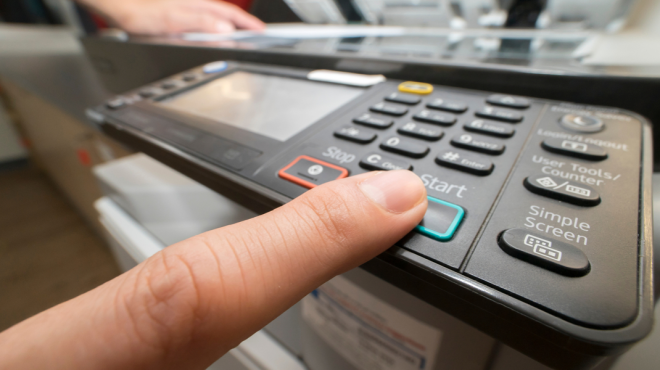You can drill rules and policies about print security into employees all day. Even the best intentions can’t always keep documents from leaving a circle of trust. It’s up to your team to do what they need to keep information confidential.
Sensitive data – like patient records or bank receipts – is easy to leave behind once it is in printed form. But what can happen once you add a unique digital signature that’s easy to trace to every single document? It becomes a lot more likely for people to take care of what they print.
As luck would have it, there are many effective ways to set up print policies that keep documents safe. Audit trails, encryption, or even simple user authentication are standard best practices that may work for you.
Here are four ways to defend your network from brutal attacks.
Your guide to print security
Safeguard against breaches
Protecting information is a critical task that can damage a business if not done right. Think about how your printer down the hall is usually overlooked as a way that attackers can exploit security gaps.
Lockdown access to your network and use secure protocols to safeguard against breaches. These links can show you how to keep sensitive information from falling into the wrong hands.
- Install an SSL Certificate onto your PaperCut server
- Enforce HTTPS or HSTS communication
- Adjust the timeout settings on your device
- Give specific permissions to different users
- Restrict access to the Application server
Verify user identities
Knowing who uses a device is the bread and butter of print management software. It’s a great way to prevent people from printing at your expense. Not only that, it’s an important safeguard to prevent unauthorized access at an MFD.
Authenticate users through card swipe, ID number, password, or other methods. If you’re not using a fully authenticated network like Windows Active Directory, you may want to consider some other options to confirm identity.

IP session-based authentication uses a login prompt to confirm users when printing. Admins can also have users to verify their identity first at a release station. This method is more complicated for users, but they won’t need any extra software to get the job done.
Trace all print jobs
According to Quocirca, 11% of all security incidents are print related. Of those events, 59% lead to a loss of data that can cost over $380,000 each year. Larger organizations may plan for that cost, but it makes a significant impact on smaller companies.
Encourage staff to think twice about what they print by linking every document to a user. You’re likely to stop and take a second look if you know your behavior can be tracked and audited.
In the most proactive environments, print security is beefed up by adding an extra layer of accountability after jobs are printed. Admins can have access to view every print job or attach a digital signature to every document.

A simple watermark can turn into a wealth of information in the event of a security incident. It’s a super-easy way to know who, what, when, where, and how a document was printed.
Meet compliance requirements
Regular security audits ensure vulnerabilities to print exploits have not crept in. Maintain an audit trail not only to protect your data but to protect your company.
With GDPR, organizations have to take ownership of how they use personal data. Keeping information secure is never easy, but it has to be done. It never hurts to use technology for document traceability and print security.
A comprehensive print management solution can help put these best practices in place. Try to apply a multi-layered strategy to keep your data safe before, during, and after documents are printed.
Get started with print security. Click here for a checklist to help you measure your system’s security.





